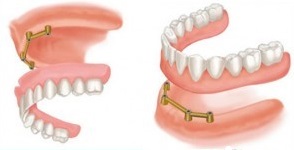
زبان بند دار و ماکروگلوسی
2015-10-25
تاریخچه جراحی سینوس
2015-10-26For an implant to succeed, there has to be an amalgamation of numerous factors, right from a good surgery to a good prosthesis and its proper maintenance. Clinical trials document a consistently high success rate for endosseous dental implants in partially and completely edentulous patients. Failures occur at a low rate, but tend to cluster in those with risk factors. Risk factor is anything that increases chances or possibility of failure
Reported predictors for implant success and failure are generally divided into patient-related factors (e.g. general patient health status, smoking habits, quantity and quality of bone, oral hygiene maintenance), implant characteristics (e.g. dimensions, coating, and loading), implant location, and clinician experience. In general, factors related to the patient appear to be more critical than those related to the implant in determining the likelihood of implant failure
Clinical trials of endosseous implants consistently rate smoking as a primary patient-centered risk factor for implant loss. Various studies report a failure rate of implants in smokers compared to nonsmokers, ranging from 6.5% to 20%.The negative impact of tobacco smoking in implant outcome may be related to multiple factors and their mechanism may be mediated through both local and systemic biologic routes
Effects of smoking on implant survival and success are more pronounced in areas of poor quality trabecular bone. In smokers, maxillary implants have more failure rate as compared to mandibular implants. Probably, maxillary bone is of lower quality and consequently more susceptible to the damaging effects of smoking. Vasoconstriction caused by the local absorption of nicotine into the bloodstream is shown to be a significant factor for implant failure by some studies. This can explain lower failure rates in the posterior mandible among smokers, since this area is covered by the tongue and hence protected against local influence of tobacco smoke
Some studies have revealed that increased tobacco use is associated with increased implant failures. Fartash published a prospective study on mandibular implant overdenture, citing higher implant failure in heavy smokers (30–40 cigarettes per day) with type IV bone. In addition, Lindquistreported significantly greater marginal bone loss around implants in heavy smokers (>14 cigarettes per day) than in those with low cigarette consumption (<14 cigarettes per day)
Smoking does not affect the process of osseointegration; rather, its negative effects seem to arise after the second-stage surgery. Gorman et al. in a study on patients who had received over 2000 implants, found significantly more failures in smokers after second-stage surgery. In a study, Lambert et al. noticed a trend of greater failures in smokers between the time after uncovering and before insertion of the prosthesis. The author theorized that the effect of tobacco on healing after implant placement was different from that after tooth extraction, because implant wounds were closed and the intimate adaptation of the implant to the bone tissue did not allow the same magnitude of interference in healing by the vasoconstrictive action of nicotine. But once the implants were uncovered, the soft tissues around them were adversely affected by tobacco in a manner similar to that by which periodontal tissues were harmfully affected. These results suggested that increased implant failure in smokers is not the result of poor healing or osseointegration, but because of exposure of peri-implant tissues to tobacco smoke
Queiroz et al. collected salivary samples of 41 subjects and determined the levels of salivary arginase activity by the measurement of l-ornithine and expressed as mIU/mg of protein. They found increased salivary arginase activity in smokers with dental implants in contrast to non-smokers with dental implants. They suggested that an increased arginase activity may lead to less nitric oxide production which consequently increases the susceptibility to bacterial infection and implant failure in smokers
Smoking also has a strong influence on the complication rates of implants. It causes significantly more marginal bone loss after implant placement, increases the incidence of peri-implantitis (deep mucosal pockets around dental implants, inflammation of the peri-implant mucosa, and increased resorption of peri-implant bone), and affects the success rates of bone grafts. The failure rate of implants placed in grafted maxillary sinuses of smokers is again two times more compared to that in nonsmokers. Kan et al. in their study found that cigarette smoking was detrimental to the success of osseointegrated implants in grafted maxillary sinuses, regardless of the amount of cigarette consumption
Marginal bone loss around implant in the smokers is more pronounced in the maxilla. In a study by Levin et al. present smokers demonstrated higher marginal bone loss during all time intervals than ex-smokers and both demonstrated higher marginal bone loss than nonsmokers. Lindquist et al. found greater marginal bone loss in smokers, but it did not lead to any implant loss over the 10-year period. Patients with the combination of smoking and poor oral hygiene had about three times greater bone loss after 10 years than nonsmokers. The higher marginal bone loss could be partially explained by the findings of Oates et al. They demonstrated elevated pyridinoline levels in the crevicular fluid associated with endosseous dental implants of smokers and suggested that smoking may affect implant success to a certain extent through alterations in the levels of bone resorption
To increase implant survival in smokers, various protocols have been recommended. Bain and Moy suggested that the patient should cease smoking at least 1 week prior to surgery to allow reversal of the increased levels of platelet adhesion and blood viscosity, as well as the short-term effects associated with nicotine. The patient should continue to avoid tobacco for at least 2 months after implant placement, by which time bone healing would have progressed to the osteoblastic phase and early osseointegration would have been established. Lambert et al. suggested that detrimental effects may be reduced by cessation of smoking, using pre-operative antibiotics and hydroxyapatite-coated implants
The key findings of this review can be summarized as follows
Smoking has adverse effects on general as well as oral health of an individual and it negatively affects the outcome of almost all therapeutic procedures performed in the oral cavity, including implant placement
Failure rate of implants is more in smokers compared to nonsmokers and is directly proportional to tobacco use
In smokers, implant failure is more in maxilla as compared to mandible and significant numbers of implants fail after second-stage surgery
In smokers, marginal bone loss and incidence of peri-implantitis is more after implant placement
Implants placed in grafted maxillary sinuses of smokers fail two times more compared to that in nonsmokers
To increase implant survival in smokers, it is advised to stop the habit 1 week prior to and up to 2 months after implant placemen






